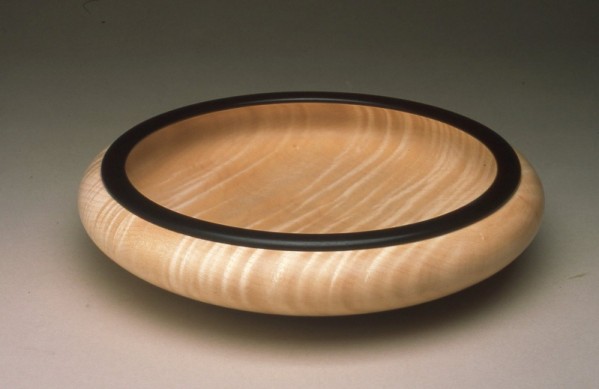Posted September 29, 2014 by David J. Marks
I received an excellent question from a woodturner who had read my article Turned Bowl with Ebony Rim in our September 2014 newsletter:/
I was just getting ready to turn a bowl from a blank that is not much thicker than the desired depth. This was leaving me nothing for the usual tenons. I asked the turning fellows in my woodworking club about gluing a waste block on the bottom and they thought I was crazy. In your latest (September 2014) newsletter, I see you are doing just that with your “Turned Bowl with Ebony Rim.”
Couple of questions:
1) How do you form the 3 inch to 4 inch flat spot for the gluing?
2)What glue do you use?
Any assistance would be appreciated.
Regards,
Andrew
Here is My Response:
Hello Andrew,
Thank you for your email and question about waste blocks.
I found it funny when I read that you “asked the turning fellows in your woodworking club about gluing a waste block on the bottom of a bowl blank and they thought you were crazy”.
It just proves once again that if you ask ten different woodturners or woodworkers a technique question, you will get more than 20 different answers!
It’s always very interesting to me when I hear so many different woodturners’ responses to different techniques for turning wood.
My approach is, I don’t really care which technique is used as long as it works and is safe and the woodturner using the technique gets the end results that he/she was looking for.
Ray Key is one of the most respected living woodturners alive today.
Here is a photo of Ray gluing a waste block on to the bottom of a bowl with ca (cyanoacrylate ) glue during his May 9th demonstration for the Wine Country Wood turners here in Sonoma County.
Ray begins by mounting a relatively dry block of wood onto a screw center chuck similar to the one in the link.
After rough turning and refining the shape of the outside of the bowl, he then flattens the bottom, which can be done with a gouge on its side or using the bevel, a scraper, or a skew in horizontal position works great as a “negative rake scraper”.
Ray applied ca glue to the bottom of the bowl, then sprayed “accelerator” onto the flat dry cherry waste block. Maple or any other fairly dense hardwood also works well for waste blocks.
Next he turned a tenon into the waste block, removed the blank from the screw chuck, and then mounted the bowl with the tenon into a four jaw chuck in order to proceed with hollowing out the inside of the bowl.
This way the full thickness of the bowl blank can be utilized for the completed bowl.
Ray’s technique is very fast and works very well.
Once the inside of the bowl is completed, then Ray reverse mounts it onto a jam chuck (block of wood mounted with a recess cut into it to accept the rim of the bowl). This way the tenon on the bottom of the bowl can be removed and the bottom turned to its completed form. It is best to use the tailstock to support the wood as much as possible and then when the tailstock is removed, masking tape can be wrapped around the bowl and jam chuck to hold it in place until the bottom is completed.
For myself, I generally flatten a piece of nice wood on my jointer, then glue on a waste block using either ca, epoxy or even Titebond glue.
I have been collecting and selling wood since the 1970’s and have a twenty foot storage building filled with exotic woods. I buy wood when I find something I like, store it in my shed, and sometimes by the time I’m ready to use it, it is no longer wet wood.
In order to speed up the process, sometimes I’ll gather a dozen pieces of wood, flatten the bottom on my 8 inch or 16 inch jointer, or if the piece is small or awkward, slice a flat on the bandsaw, then finish flattening it on my disc sander. Yellow glue works fine as long as the two matting surfaces are flat. If they are close but not truly flat, then I’ll use 5 minute epoxy which is a “gap filling glue”. If you test the wood with a moisture meter and it is is somewhere around 16 – 18 percent, then I would recommend using a polyurethane glue like Gorilla Glue or I would recommend using ca (cyanoacrylate) glue. Both of these glues will bond to a surface that has moisture in it.
Either way, waste blocks are an excellent choice for maximizing a unique block of wood.
Thank you for your question Andrew and always question your fellow woodworkers and woodturners until you find a solution that works best for your own individual needs.
Please feel free to share my response with your fellow woodturners and remind them that we all share information which is constantly being updated so that we can all help each other. I don’t believe that there is ever a “stupid or crazy question”. There are only new or innovative solutions and they all start with “problem solving”.
Please check out my website and share it with your fellow woodworkers. We are all in this together.
I wish you great success and safe turning,
David


2 thoughts on “Follow Up to Turned Bowl with Ebony Rim Article: How to Glue On A Waste Block”
I constantly use a sacrificial glue block and have good results.
Thank you for the tip. I was wondering about doing this, and searched the web for insights. You delivered the insight I was hoping to find, so I can now go about it in confidence.
Comments are closed.